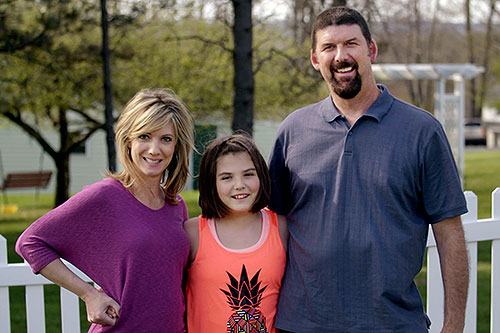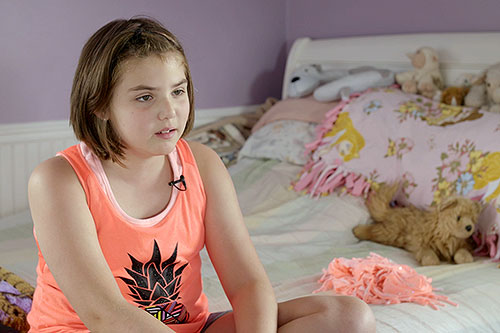‘SHE’S NOT GOING INTO HOSPICE’: Child’s Medical Miracle Fueled by IBEW Generosity
September 21, 2016
Long before Emily Whitehead became an international figure in the fight against leukemia, her mother and father assured her they would be by her side every day.

|
| The Whitehead family outside their home in Phillipsburg, Pa. From left, Kari Whitehead, Emily Whitehead and Tom Whitehead.
|
Tom Whitehead said that was possible because of the generosity of IBEW members across North America, who donated money and vacation days to get them through one of the worst ordeals a family can face.
“We were very fortunate,” said Tom, a member of Johnstown, Pa., Local 459 and a lineman for Penelec of First Energy. “We saw other families that lost their job, who lost their houses, who had to go completely into the welfare system when their children are going through treatment.”
Delegates to the 39th IBEW Convention viewed a video during the session on Wednesday morning in St. Louis. The Whiteheads’ journey started in May 2010 at their home in Phillipsburg, Pa., when Tom and his wife Kari noticed excessive bruising on their then 6-year-old daughter’s body. Emily, their only child, also was bleeding from her gums and complaining of leg pain. She was diagnosed with acute lymphoblastic leukemia.
Emily initially responded well to chemotherapy, but twice relapsed; her outlook was dire by April 2012. One doctor suggested the family look into hospice care for her, Tom said.
With few options remaining, the Whiteheads learned about an experimental treatment at Children’s Hospital of Philadelphia that had never been tried on a child. In it, doctors would use a disabled virus that causes AIDS to kill the cancer cells.
Doctors would remove millions of T-cells – a type of white blood cell -- from Emily’s body and insert new genes they thought would allow the T-cells to attack B-cells, a part of the immune system that turns malignant for patients suffering from leukemia. The altered T-cells would be inserted back in Emily’s body, where they hopefully would multiply and destroy the cancerous cells.
The Whiteheads didn’t hesitate after the doctors told them Emily had no chance of contracting the AIDS virus.
“We said, ‘Give us the consent forms,’ ” Tom said. “Emily is not going into hospice.”
The first night following the trial was a terrifying one. Emily’s blood pressure dropped and her fever spiked at 105 degrees. She struggled to breathe and her lungs were filled with fluid. Doctors induced a coma and she was connected to more than 20 IV lines, Tom said.

|
| Emily Whitehead discusses her cancer treatment in an interview earlier this year.
|
“She told me before she went to sleep that I had to promise I wouldn’t leave the room,” Tom said. “She wanted me to keep holding her throughout the whole process.”
Following a series of blood tests, Dr. Stephan Grupp, Emily’s oncologist, ordered the administration of tocilizumab, a drug often used by rheumatoid arthritis patients. It is resistant to aggressive T-cells and Grupp thought it could counter some of the trial’s aftereffects.
The plan worked. Emily had awakened by her seventh birthday on May 2, 2012. On May 10, Grupp told Tom and Kari their daughter was leukemia free. Today, doctors continue T-cell transplant trials on other patients.
“Honestly, there was no hope for a patient like this before 2012,” Grupp said. “There was nothing that was going to work for her.”
“We now know it works on leukemia,” he added. “We’re able to put about 90 percent [of the cases they work with] into remission. The further level of excitement is kind of what we’re engaged in right now, to try to find out if we can do this with other kinds of cancers.”
While all this was going on, Local 459 members rallied to donate vacation days and money to allow the Whiteheads to continue to be with Emily during her treatments. So did other employees at Penn State, where Kari works as a research and evaluation associate in the school’s Clearinghouse for Military Family Readiness.
Tom said he was able to take 280 vacation hours in 2011 – almost seven weeks. In 2012, when Emily’s condition was its most dire, he took 520 hours – 65 full days, thanks to vacation days supplied by fellow IBEW members.
Donations covered most of the expenses not covered by insurance or Medicare, which the Whiteheads qualified for. The Penn State Dance Marathon, which annually donates millions of dollars to childhood cancer causes, also supported the Whiteheads.
“I never missed a 40-hour paycheck,” Tom said. “We never missed a meal. To know they were willing to donate to me to save my daughter’s life, it’s really hard to put into words how much it meant to us.”
Co-workers, fellow union members, neighbors, even strangers in the broader community around Phillipsburg adopted the fight and took it on as their own.
“We all consider Tom a brother and we’ve all become attached to Emily,” Local 459 Business Manager Paul L. Cameron said.
The New York Times featured Emily’s revolutionary treatment and recovery in a front-page story in December 2012. Other media outlets picked up on it and she’s been a celebrity ever since, meeting President Obama and actor Bradley Cooper.
Sean Parker, the founder of Napster, flew the family to California in April of this year for a gala to announce the launch of the Parker Institute for Cancer Immunotherapy. Now 11, Emily Whitehead is a regular sixth-grader and plays volleyball.
The letters and offers to help still come in and Tom said it’s proven impossible to send thank-you notes to everyone. But the family is trying to pay it forward in their own way.
In 2014, the Whiteheads started the Emily Whitehead Foundation to provide funding for childhood cancer research and to help make T-cell therapy available to more families.
“The only thing we asked for throughout Emily’s treatment were prayers to help her get through each day, but we received so much more from people around the world,” reads a note on the foundation’s website. “We are thankful for every day we spend with Emily. We have been given so much and we hope to give back much more in return.”
Tom says much the same thing today – and his fellow IBEW members played a big part in it.
“The support I’ve received from all my brothers and sisters out there has saved my daughter’s life,” he said. “I couldn’t be prouder to be part of this organization, so thank you.”